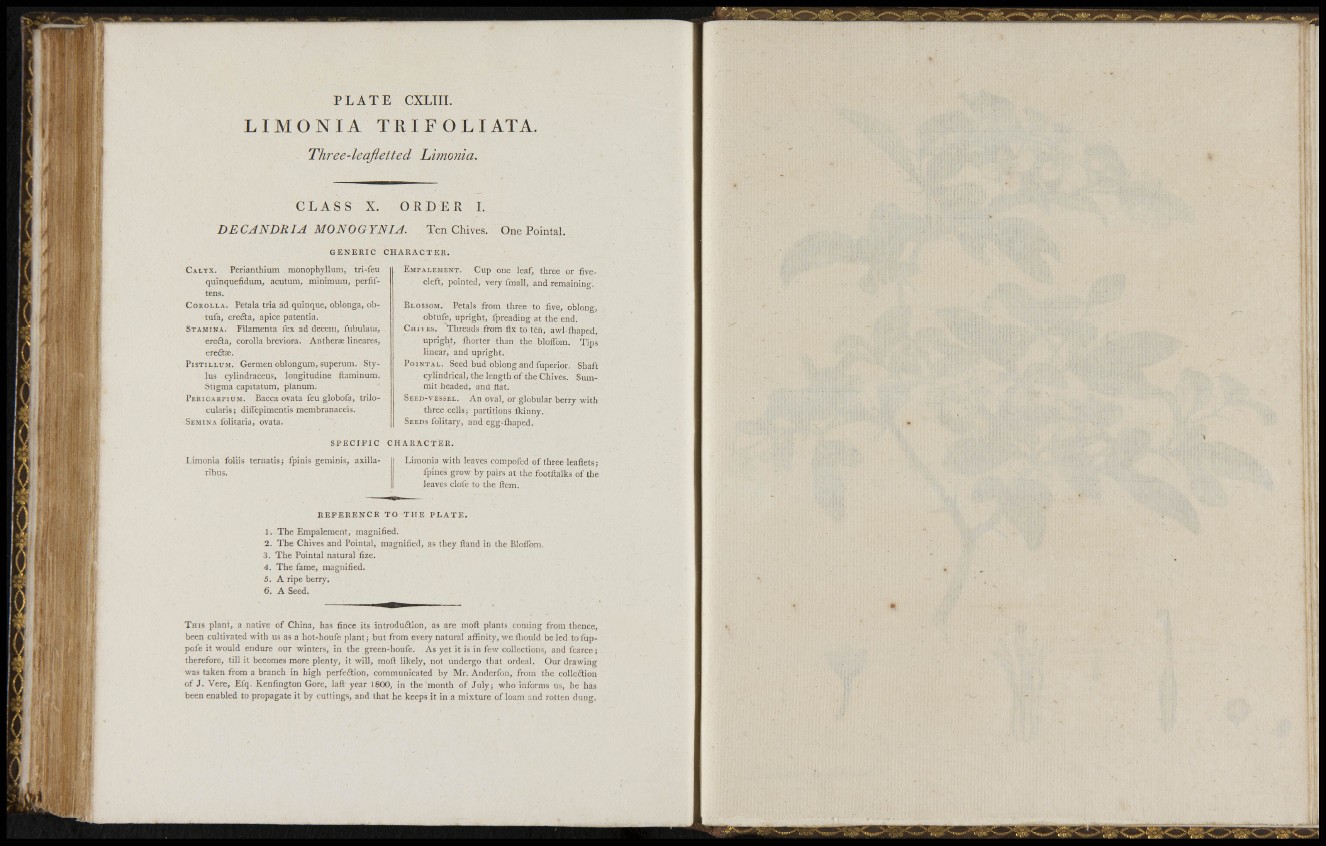
r
Vi
L
i.'
_ • ;¡ í il|
vn:
t .. {Ì
1! iI 1 Ï 1 -r
t T"
' f
P L A T E CXLTII.
L I M O N I A TRI F O L I AT A.
Three-leajietted himonia.
C L A S S X. ORDER L
DECJNDRIA MONOGYNIA. Ten Chives. One Pointai.
GENERIC CHARACTER.
CALYX. Perianthium monophyllum, tri-ieu
quinquefidum, acutum, minimum^ perfiltens.
COROLLA. Pétala tria ad quinqué, oblonga, obtufa,
ereña, apice patentia.
STAMINA. Filamenta iex ad decern, Cubulata^
ere£ta, corolla breviora. Antherae lineares,
e r e f t s .
PisTiLLUM. Germen oblongura, superuni. Stylus
cylindraceus, longitudine ftaminum.
Stigma capitatum, planum.
PERICAKPIUH. Bacca ovata feu globofa, trilocularis
; dilTepimentis membranaceis.
SEMISA íblitaria, ovata.
EMPALEMENT. Cup one leaf, three or fivecleft,
pointed, very fraall, and remaining.
BLOSSOM. Petals from three to five, oblong,
obtufe, upright, fpreading at the end.
CHIVES. Threads from fix to ten, awl-fliaped,
upright, lliorter than the bloflbm. Tips
linear, and upright.
POINTAL. Seed bud oblong and fuperior. Shaft
cylindrical, the length of the Chives. Summit
headed, and flat.
SEED-VESSEL. An oval, or globular berry with
three cells; partitions Ikinny.
SEEDS folitary, and egg-fhaped.
S P E C I F I C CHARACTER.
Limonia foliis ternatis; fpinis geminis, axillaribus.
Limonia with leaves compofed of three leaflets;
fpines grow by pairs at the footftalks of the
leaves clofe to the ftem.
REFERENCE TO THE PLATE.
1. The Empalement, magnified.
2. The Chives and Pointal, magnified, as they ftand in the Bloflbm.
3. The Pointal natural fize.
4. The fame, magnified.
5. A ripe berry.
6 . A Seed.
THIS plant, a native of China, has fince its introduilion, as are moil plants coming from tlicnce,
been cultivated with us as a hot-houfe plant; but from every natural affinity, w e fliould be led to fuppofe
it would endure our winters, in the green-houfe. As yet it is in few collections, and fcarce;
therefore, till it becomes more plenty, it will, moft likely, not undergo tliat ordeal. Our drawing
was taken from a branch in high perfeftion, communicated by Mr. Anderfon, from the colleQion
of J. Vere, Efq. Kenfington Gore, laft year 1800, in the month of .Inly; who informs us, he has
been enabled to propagate it by cuttings, and that he keeps it in a mixture of loam and rotten clung.
y«—-. ífSí*^,-»^
f t
* 1
I i